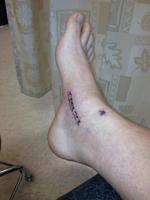Diseases & Conditions
Patient Story: Ankle Fracture and Chronic Ankle Laxity

Aime Franco has been dealing with ankle problems her entire life. When she was in second grade, she sustained a fracture. Her ankle remained chronically unstable, causing numerous strains and sprains in the years that followed.
In February 2007, Aime suffered a severe ankle sprain. At the time, she was pregnant with her second child. "I was told I would need to have surgery," she recalls. "I sprained it too many times and had compromised the functionality and stability of the ankle joint."
In December of that year, Aime had reconstructive surgery to stabilize her ankle. The lateral ligaments and tendons were tightened. The surgeon also lengthened her gastrocnemius muscle--a muscle in the calf that runs from ankle to heel—to help prevent her ankle from rolling. The surgery was a success; Aime finally had relief from pain and instability.
Aime was able to confidently participate in activities that she had always loved. She went on hikes and walks with her family. She spent time outside and started running on a regular basis. Aime set a goal for herself: to complete a marathon before she turned 40.
During a training run in 2013, Aime's ankle broke again. Unlike her prior ankle pain, the pain from this injury was on the inside of her ankle. Aime was in a walking boot for ten weeks and went through two months of physical therapy. "Even after the physical therapy I was never able to get back to the point I was before the injury, and still experienced chronic pain with all activities," she says.
Aime's quality of life was rapidly diminishing. She was constantly in pain, and gained weight due to inactivity. After visiting two specialists, an MRI revealed that she had an accessory navicular bone in her ankle. This extra bone growth near the ankle is uncommon, and requires surgery if it becomes symptomatic. "We tried steroid injections to relieve the swelling around the bone, but this did not reduce the pain and we ultimately decided that surgery was the best option," she says.

The decision to have another surgery was difficult for Aime. She knew it would mean a loss of independence, and at least three months in which she would be unable to help care for her children or get around on her own. Ultimately, she decided the chance of returning to her active lifestyle was worth the temporary setback, and in January 2014, she had surgery to remove the accessory navicular and clean out the ankle to remove debris. In addition, Aime had a modified Kidner procedure, which involved removing the posterior tibial tendon from the bone and reanchoring it back to the bones in the arch of her foot.
Aime is still recovering from her surgery. She is not cleared for activities and has not yet started physical therapy. However, her surgeon predicts she has an 85% chance of complete recovery, and that she will be able to run and bike again. "I still am planning to compete in that marathon before age 40, and will do everything I can with physical therapy to regain all the strength that I am losing after this last surgery."
Aime, who has a degree in sports medicine and athletic training, has learned to adapt to her weaknesses and strengths. She never allowed her ankle laxity to hold her back; she always worked hard to make sure it was as strong as possible. She knows she still faces many challenges in the road to recovery, but she's ready to face them head on.
Last Reviewed
September 2014
AAOS does not endorse any treatments, procedures, products, or physicians referenced herein. This information is provided as an educational service and is not intended to serve as medical advice. Anyone seeking specific orthopaedic advice or assistance should consult his or her orthopaedic surgeon, or locate one in your area through the AAOS Find an Orthopaedist program on this website.






